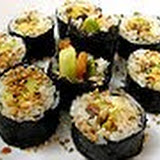
All sushi has a base of specially prepared rice,complemented with other ingredients.
3.1 Sushi rice.
Sushi is made with white,short-grained,Japanese rice mixed with a dressing made of and rice vinegar,sugar,salt and occasionally kombu and sake.It is usually cooled to room temperature before being used for a filling in a sushi.In some fusion cuisine restaurants,short grain brown rice and wild rice are also used.
Sushi rice(sushi-meshi)is prepared with short-grain Japanese rice,which has a consistency that differs from long-grain strains such as those from India.The essential quality is its stickiness.Rice that is too sticky has a mushy texture;if not sticky enough,it feels dry.Freshly harvested rice(shinmai)typically has too much water and requires extra time to drain the rice cooker after washing.
There are regional variation in sushi rice and,of course,individual methods.Most of the variations are in the rice vinegar dressing:the Tokyo version of the dressing commonly uses more salt;in Osaka,the dressing has more sugar.
3.2 Nori.(See image at the top:a sheet of Nori)
The seaweed wrappers used in maki and temaki are called nori.Nori is an algae,traditionally cultivated into the harbors of Japan.Originally,algae was scraped from dock pilings,rolled out into thin,edible sheets,and dried in the sun,in a process similar to making rice paper.
Whereas in Japan,nori may never be toasted before being used in food,many brands found in the U.S. reach drying temperatures above 108 degrees Fahrenheit.Today,the commercial product is farmed,produced,toasted,packaged and sold in standard-size sheets in about 18cm. by 21cm.(7 in.by 8 in.).Higher quality nori is thick,smooth,shiny green and has no holes.When stored for wnseveral month,nori sheets can change color to dark green-brownish.
Nori by itself is an edible snack and is available with salt or flavored with teriyaki sauce.The flavored variety,however,tends to be of lesser quality and is not suitable for sushi.
When making fukusazushi,a paper-thin omelette may replace a sheet of nori as the wrapping.The omelette is traditionally made on a rectangular omelette pan(makiyakinabe) and used to form the pouch for the rice and fillings.
3.3 Toppings and fillings Main article: List of sushi and sashimi ingredients
- Fish
Aburi style refers to nigiri sushi where the fish is partially grilled(top side)and partially raw.Most nigiri sushi will be completely raw.
- Seafood
(ebi and amaebi),clam(mirugai,aoyagi and akagi),fish roe(ikura,masago,kazunoko and tobiko),
sea urchin(uni),crab(kani) and various kinds of shellfish(abalone,prawn,scallop)are the most popular seafoods in sushi.Oysters,however,are less common,as the taste is not thought to do well with the rice.Kani kama,or imitation crab stick,is commonly substituted for real crab,most notably in California rolls.
- Vegetables
- Other fillings
3.4 Condiments
- Shoyu
- Wasabi
An imitation wasabi(seiyo-wasabi),made from horseradish and mustard powder and dyed green is common.It is found at lower-end kaitenzushi restaurants,in bento box sushi and at most restaurants outside of Japan,it may be labelled "Japanese Horseradish".
- Gari
- Ocha

No comments:
Post a Comment